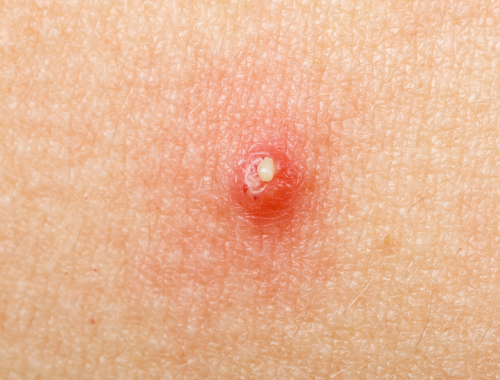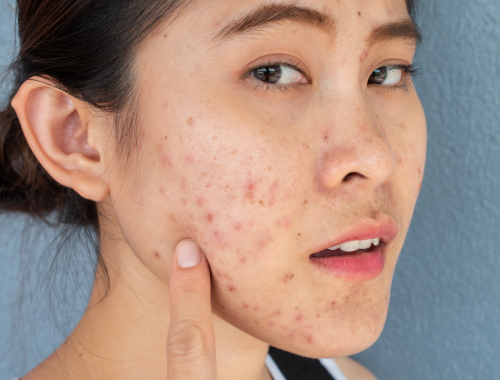Difference Between Pustules and Papules
Pustules are pus-filled fluid collections that are one cm in diameter. Papules are elevated skin regions that are less than one cm long.

What are Pustules?
Definition:
Pustules are pus-filled fluid collections that are one cm in diameter.
Causes:
Pustules may form secondary to infections. These can occur as an allergic reaction to food or allergens. Cystic acne also causes pustule eruption.
Appearance:
Pustules appear as tender red bumps on the skin with a white fluid-filled center. These are common on the face, chest, trunk, and hairline.
Diagnosis:
Pustules are diagnosed easily on physical examination.
Treatment:
Over-the-counter acne medications, creams, and lotions are used to treat small pustules. Pustules that are long-lasting need to be treated by a dermatologist. The doctor might prescribe oral antibiotics like doxycycline, or topical creams containing dapsone or salicylic acid. In severe cases, photodynamic therapy might be needed to get rid of pustules.

What are Papules?
Definition:
Papules are elevated skin regions that are less than one cm long.
Causes:
Papules are common in conditions like contact dermatitis, warts caused by human papillomavirus (HPV), actinic keratosis, seborrheic keratosis, cherry angioma, molluscum contagiosum, eczema, lichen planus, leprosy, chickenpox and shingles, and insect bites.
Appearance:
Papules are less than one centimeter-sized raised skin lesions that are flat, dome-shaped, or umbilicated. They are usually of the same color as the skin.
Diagnosis:
Papules are diagnosed based on physical appearance.
Treatment:
Treatment of papules depends on the cause. Avoid putting makeup or lotions on the affected region. In the case of chickenpox or other infectious skin conditions, medications should be taken only if prescribed by a doctor. In case of eczema emollients and steroids may be given after the doctor’s prescription.
Difference between Pustules and Papules
Definition:
Pustules are pus-filled fluid collections that are one cm in diameter. Papules are elevated skin regions that are less than one cm long.
Causes:
Pustules may form secondary to infections. These can occur as an allergic reaction to food or allergens. Cystic acne also causes pustule eruption. Papules are common in conditions like contact dermatitis, warts caused by human papillomavirus (HPV), actinic keratosis, seborrheic keratosis, cherry angioma, molluscum contagiosum, eczema, lichen planus, leprosy, chickenpox and shingles, and insect bites.
Appearance:
Pustules appear as tender red bumps on the skin with a white fluid-filled center. These are common on the face, chest, trunk, and hairline.
Papules are less than one centimeter-sized raised skin lesions that are flat, dome-shaped, or umbilicated. They are usually of the same color as the skin.
Diagnosis:
Pustules are diagnosed easily on physical examination. Papules are diagnosed based on physical appearance.
Treatment:
Over-the-counter acne medications, creams, and lotions are used to treat small pustules. Pustules that are long-lasting need to be treated by a dermatologist. The doctor might prescribe oral antibiotics like doxycycline, or topical creams containing dapsone or salicylic acid. In severe cases, photodynamic therapy might be needed to get rid of pustules. Treatment of papules depends on the cause. Avoid putting makeup or lotions on the affected region. In the case of chickenpox or other infectious skin conditions, medications should be taken only if prescribed by a doctor. Incase of eczema emollients and steroids may be given after the doctor’s prescription.
Table of differences between Pustules and Papules

FAQs
Is a pimple a papule or pustule?
Pimple is a type of pustule.
Does a papule become a pustule?
Yes, a papule can become a pustule.
What is a papule vs pustule vs comedone?
Pustules are pus-filled fluid collections that are one cm in diameter. Papules are elevated skin regions that are less than one cm long. Comedones are papules common on the face or forehead.
What do pustules look like?
Pustules appear as tender red bumps on the skin with a white fluid-filled center. These are common on the face, chest, trunk, and hairline.
Can you pop pustules?
It is not recommended to pop a pustule.
Is it okay to pop pustule pimples?
It is not recommended as it can lead to inflammation.
- Differences Between Reptiles and Amphibians - May 17, 2024
- Difference Between Ophthalmology and Optometry - May 15, 2024
- Difference Between Fear and Anxiety - April 2, 2024
Search DifferenceBetween.net :
Leave a Response
References :
[0]Lipsker, Dan, and Dan Lipsker. "Pustules." Clinical Examination and Differential Diagnosis of Skin Lesions (2013): 181-182.
[1]Whitfeld, Margot, et al. "Staphylococcus epidermidis: a possible role in the pustules of rosacea." Journal of the American Academy of Dermatology 64.1 (2011): 49-52.
[2]Donati, Aline, et al. "Facial papules in frontal fibrosing alopecia: evidence of vellus follicle involvement." Archives of dermatology 147.12 (2011): 1424-1427.
[3]Image credit: https://www.canva.com/photos/MADFt1fPOWQ-pustulous-cystic-acne/
[4]Image credit: https://www.canva.com/photos/MAELOFY9c2A-portrait-of-ugly-asian-woman-having-problems-of-acne-inflammation-papule-and-pustule-on-her-face-/
